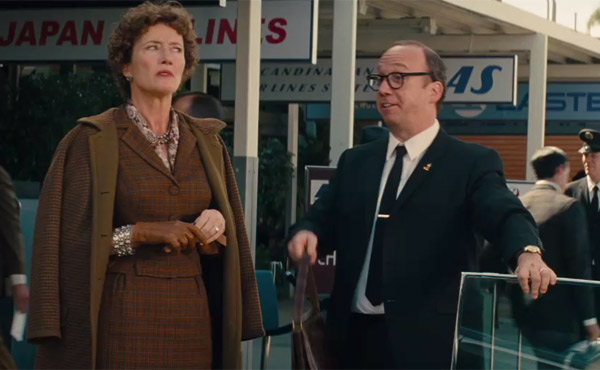Rules
In order to make this list as relevant as possible and to facilitate my selection, I have decided on certain restrictions when choosing my films of the year. First of all, I will obviously limit myself to films which have seen. While I managed to catch most major 2013 releases, I missed some films which might have made my top 13 (i.e. A Field in England, Upstream Color, The Act of Killing, The Smurfs 2). Another condition is that they have to have had a general 2013 release in one of the two countries in which I usually go to the cinema: the UK and Luxembourg. This eliminates a number of films I’ve seen at festivals such as Stray Dogs, 12 Years a Slave or The Zero Theorem. Furthermore, films which were part of last year’s awards race, but not released until early 2013 (Zero Dark Thirty, Les Misérables, No) will not be taken into consideration, as they feel very much like 2012 films.
Honorable Mentions
About Time
Behind the Candelabra
Despicable me 2
Frances Ha
La grande bellezza (The Great Beauty)
The Hunger Games: Catching Fire
Nebraska
Le passé (The Past)
Pacific Rim
Philomena
The Selfish Giant
Le temps de l’aventure (Just a Sigh)
Tian zhu ding (A Touch of Sin)
You’re Next
La Vie d’Adèle (Blue is the Warmest Colour)
 For some inexplicable reason, I had never seen Disney classic Mary Poppins (a mistake which has been duly corrected since) nor read any of the books, before seeing John Lee Hancock’s Saving Mr Banks, the closing film of the 57th BFI London Film Festival. Aside from knowing the basic premise of the story (a magical nanny arrives with her flying umbrella in an ordinary London family) and some vague memories of the songs, I did not know anything about the 1961 film. Fortunately this is not mandatory (though highly recommended) in order to feel the delight of Saving Mr Banks, which tells the story of the making of Mary Poppins, or rather the story of the author of the source novel P.J. Travers.
For some inexplicable reason, I had never seen Disney classic Mary Poppins (a mistake which has been duly corrected since) nor read any of the books, before seeing John Lee Hancock’s Saving Mr Banks, the closing film of the 57th BFI London Film Festival. Aside from knowing the basic premise of the story (a magical nanny arrives with her flying umbrella in an ordinary London family) and some vague memories of the songs, I did not know anything about the 1961 film. Fortunately this is not mandatory (though highly recommended) in order to feel the delight of Saving Mr Banks, which tells the story of the making of Mary Poppins, or rather the story of the author of the source novel P.J. Travers.
In a way, Saving Mr Banks is two movies squeezed into one. Firstly, there is the story of the famous writer P.J. Travers (Emma Thompson), who travels to Los Angeles in order to oversee the Hollywood adaptation of her most famous work for Walt Disney (Tom Hanks). Extremely protective of her work and reluctant to let go of her work, Travers, who had script-approval, was extremely difficult to work with, making impossible requests. At one point, she even demanded that the colour red was not to be used in the film. This narrative is intertwined with flashbacks, which show a young Travers (Annie Buckley) growing up in rural Australia with an alcoholic father (Colin Farrell) and a mother unable to cope with the situation (Ruth Wilson).
These flashbacks are rather bleak and depressing, even though Colin Farrell manages to bring some warmth to these sequences. While they are genuinely moving and important to the main story, as they explain P.J. Travers’ stubbornness, the flashbacks are arguably the weakest part of the film. In fact, they feel a bit too separate from the main plot, almost like a different film, and they take longer than it takes us to understand their message. That said, having a slightly overlong, tragically moving backstory as the biggest weakness is not too shabby.
The main story on the other hand is an absolute feel-good delight, in the classic Disney fashion. The only thing that distinguishes it from a classic Disney film is that its target audience is slightly more grown-up. It’s funny, it’s moving, it’s comforting, it’s everything you want from a Disney film and it has very few rough edges. Tom Hanks is perfectly cast as Walt Disney. He has this child-like, innocent quality which suits the part. As for Emma Thompson, I could easily write this entire review about how brilliant she is. She is, to keep it short, supercalifragilisticexpialidocious and more. It is very much her film (Hanks is more of a supporting actor), and she brings incredible warmth to a character which starts out as grumpy, miserable and annoying; and when she starts being won over, I wasn’t the only person in the audience who suddenly had “something in their eye.”
Saving Mr Banks is an absolute must see for fans of Mary Poppins (according to the director and screenwriters, there are numerous references and in-jokes for fans of the classic to discover).Unashamedly moving and feel-good, you will walk out of the cinema with a huge grin on your face, humming “Let’s go fly a kite”
PS: I also want to mention a beautiful subplot which involves P.J. Travers befriends her driver, played by one of my favourite actors Paul Giamatti, which shows the quality of Kelly Marcel and Sue Smith’s script.

No comments:
Post a Comment